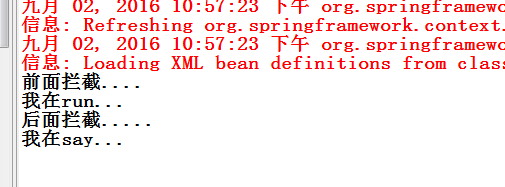您好,登录后才能下订单哦!
小编给大家分享一下Spring AOP中如何实现自动代理,相信大部分人都还不怎么了解,因此分享这篇文章给大家参考一下,希望大家阅读完这篇文章后大有收获,下面让我们一起去了解一下吧!
这里的自动代理,我讲的是自动代理bean对象,其实就是在xml中让我们不用配置代理工厂,也就是不用配置class为org.springframework.aop.framework.ProxyFactoryBean的bean。
总结了一下自己目前所学的知识。
发现有三种方式实现自动代理
用Spring一个自动代理类DefaultAdvisorAutoProxyCreator:
<bean class="org.springframework.aop.framework.autoproxy.DefaultAdvisorAutoProxyCreator" data-filtered="filtered"></bean>
例如:
原来不用自动代理的配置文件如下:
<!--?xml version="1.0" encoding="UTF-8"?--> <beans xmlns="https://www.springframework.org/schema/beans" xmlns:context="https://www.springframework.org/schema/context" xmlns:tx="https://www.springframework.org/schema/tx" xmlns:xsi="https://www.w3.org/2001/XMLSchema-instance" xsi:schemalocation="https://www.springframework.org/schema/beans https://www.springframework.org/schema/beans/spring-beans-4.3.xsd https://www.springframework.org/schema/context https://www.springframework.org/schema/context/spring-context-4.3.xsd https://www.springframework.org/schema/tx https://www.springframework.org/schema/tx/spring-tx-4.3.xsd"> <!-- 代理前原对象 --> <bean class="cn.hncu.xmlImpl.Person" id="person"></bean> <!-- 切面 = 切点+通知 --> <bean class="org.springframework.aop.support.RegexpMethodPointcutAdvisor" id="advisor"> <!-- 切点 --> <property name="patterns"> <list> <value>.*run.*</value> </list> </property> <!-- 通知-由我们写,实际代理动作 --> <property name="advice"> <bean class="cn.hncu.xmlImpl.AroundAdvice" id="advice"></bean> </property> </bean> <!-- 代理工厂 --> <bean class="org.springframework.aop.framework.ProxyFactoryBean" id="personProxied"> <!-- 放入原型对象 --> <property name="target" ref="person"></property> <!-- 放入切面 --> <property name="interceptorNames"> <list> <value>advisor</value> </list> </property> </bean> </beans>
现在改用自动代理,如下配置:
<beans ...=""> <!-- 代理前原对象 --> <bean class="cn.hncu.xmlImpl.Person" id="person"></bean> <!-- 切面 = 切点+通知 --> <bean class="org.springframework.aop.support.RegexpMethodPointcutAdvisor" id="advisor"> <!-- 切点 --> <property name="patterns"> <list> <value>.*run.*</value> </list> </property> <!-- 通知-由我们写,实际代理动作 --> <property name="advice"> <bean class="cn.hncu.xmlImpl.AroundAdvice" id="advice"></bean> </property> </bean> <!-- 自动代理 --> <bean class="org.springframework.aop.framework.autoproxy.DefaultAdvisorAutoProxyCreator"></bean> </beans>
测试方法
@Test//自动代理
public void demo4(){
ApplicationContext ctx = new ClassPathXmlApplicationContext("cn/hncu/xmlImpl/4.xml");
//我们直接在这里获取Person对象就可以了,因为在最开始xml文件newPerson对象后,Spring就已经帮我们代理了!
Person p =ctx.getBean(Person.class);
p.run();
p.say();
}相对于前面,也就是把代理工厂部分换成自动代理了。
演示结果:

自己写一个自动代理底层实现:
我们也可以写一个类,来实现DefaultAdvisorAutoProxyCreator自动代理的功能!
首先,我们需要实现一个接口,也就是BeanPostProcessor接口。
BeanPostProcessor接口作用是:如果我们需要在Spring容器完成Bean的实例化、配置和其他的初始化前后添加一些自己的逻辑处理,我们就可以定义一个或者多个BeanPostProcessor接口的实现,然后注册到容器中。
而我们想要在原型对象bean被创建之后就代理了,就必须在原来的容器中拿到原来的原型对象,需要拿到原来spring容器中的切面对象,这个时候,我们就需要原来的容器,这个时候就需要另一个接口,也就是ApplicationContextAware接口!
通过这2个接口,我们就可以实现自动代理了。
package cn.hncu.xmlImpl;
import org.springframework.aop.Advisor;
import org.springframework.aop.framework.ProxyFactoryBean;
import org.springframework.beans.BeansException;
import org.springframework.beans.factory.config.BeanPostProcessor;
import org.springframework.context.ApplicationContext;
import org.springframework.context.ApplicationContextAware;
public class MyAutoProxy implements BeanPostProcessor,ApplicationContextAware{
private ApplicationContext applicationContext=null;
//bean创建之前调用
@Override
public Object postProcessBeforeInitialization(Object bean, String beanName)
throws BeansException {
return bean;//在这里,我们直接放行
}
//bean创建之后调用
@Override
public Object postProcessAfterInitialization(Object bean, String beanName)
throws BeansException {
ProxyFactoryBean factory = new ProxyFactoryBean();
//把原型对象放入代理工厂
factory.setTarget(bean);
//在这里
Advisor adv = applicationContext.getBean(Advisor.class);
factory.addAdvisor(adv);
//返回被代理后的对象
return factory.getObject();
}
//拿到原来的spring中的容器
@Override
public void setApplicationContext(ApplicationContext applicationContext)
throws BeansException {
this.applicationContext=applicationContext;
}
}5.xml
<beans...> <!-- 代理前原对象 --> <bean class="cn.hncu.xmlImpl.Person" id="person"></bean> <!-- 切面 = 切点+通知 --> <bean class="org.springframework.aop.support.RegexpMethodPointcutAdvisor" id="advisor"> <!-- 切点 --> <property name="patterns"> <list> <value>.*run.*</value> </list> </property> <!-- 通知-由我们写,实际代理动作 --> <property name="advice"> <bean class="cn.hncu.xmlImpl.AroundAdvice" id="advice"></bean> </property> </bean> <!-- 自己写的自动代理 --> <bean class="cn.hncu.xmlImpl.MyAutoProxy"></bean> </beans...>
测试方法:
@Test//自己实现的自动代理
public void demo5(){
ApplicationContext ctx = new ClassPathXmlApplicationContext("cn/hncu/xmlImpl/5.xml");
Person p =ctx.getBean(Person.class);
p.run();
p.say();
}测试结果就不上图了,和前面是一样的。
其实很多时候,我们如果自己去练一下底层,对上层的框架更好理解。
还有一种方法。
使用aop标签配自动代理
需要在beans加一个命名空间
xmlns:aop=https://www.springframework.org/schema/aop
还需要配xsi:schemaLocation,为aop加一个网络地址。
https://www.springframework.org/schema/aop https://www.springframework.org/schema/aop/spring-aop-4.3.xsd
我们需要一个aspectjweaver-jar包:
xml配置文件:
<!--?xml version="1.0" encoding="UTF-8"?--> <beans xmlns="https://www.springframework.org/schema/beans" xmlns:aop="https://www.springframework.org/schema/aop" xmlns:context="https://www.springframework.org/schema/context" xmlns:tx="https://www.springframework.org/schema/tx" xmlns:xsi="https://www.w3.org/2001/XMLSchema-instance" xsi:schemalocation="https://www.springframework.org/schema/beans https://www.springframework.org/schema/beans/spring-beans-4.3.xsd https://www.springframework.org/schema/context https://www.springframework.org/schema/context/spring-context-4.3.xsd https://www.springframework.org/schema/tx https://www.springframework.org/schema/tx/spring-tx-4.3.xsd https://www.springframework.org/schema/aop https://www.springframework.org/schema/aop/spring-aop-4.3.xsd "> <!-- 利用sop标签实现自动代理 --> </aop:aspectj-autoproxy> <!-- 代理前原对象 --> <bean class="cn.hncu.xmlImpl.Person" id="person"></bean> <!-- 切面 = 切点+通知 --> <bean class="org.springframework.aop.support.RegexpMethodPointcutAdvisor" id="advisor"> <!-- 切点 --> <property name="patterns"> <list> <value>.*run.*</value> </list> </property> <!-- 通知-由我们写,实际代理动作 --> <property name="advice"> <bean class="cn.hncu.xmlImpl.AroundAdvice" id="advice"></bean> </property> </bean> </beans>
测试方法:
@Test//自动代理
public void demo6(){
ApplicationContext ctx = new ClassPathXmlApplicationContext("cn/hncu/xmlImpl/6.xml");
Person p =ctx.getBean(Person.class);
p.run();
p.say();
}测试结果:

以上是“Spring AOP中如何实现自动代理”这篇文章的所有内容,感谢各位的阅读!相信大家都有了一定的了解,希望分享的内容对大家有所帮助,如果还想学习更多知识,欢迎关注亿速云行业资讯频道!
免责声明:本站发布的内容(图片、视频和文字)以原创、转载和分享为主,文章观点不代表本网站立场,如果涉及侵权请联系站长邮箱:is@yisu.com进行举报,并提供相关证据,一经查实,将立刻删除涉嫌侵权内容。